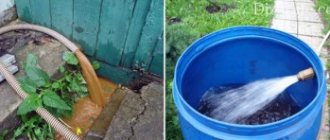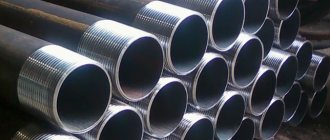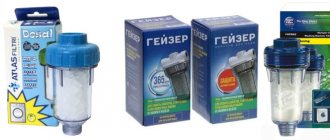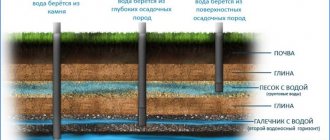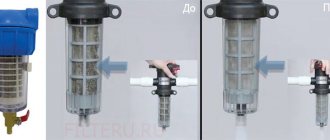It is almost impossible to obtain water suitable for cooking without special equipment. The water may contain sand particles and other contaminants, which are easy to remove. However, not every owner of a private house knows why rusty water comes from a well and how to get rid of this problem.
Rusty water comes from the well.
How to recognize the presence of iron in water
One of the main methods for determining the presence of iron in water from a well is its settling. After some time, unnoticeable at first, iron dissolved in water begins to interact with oxygen in the air, resulting in the process of its oxidation and a brown precipitate can be seen at the bottom of the container.
In some cases, you may notice that the water collected from the well has an iron smell. This is another sign of iron content in water.
What is rust
Iron is a reactive metal that undergoes rapid oxidation upon contact with oxygen and water. During this interaction, various compounds are formed, including hydrates, hydroxides and oxides. There is no exact formula for rust, since depending on environmental conditions it has a variable composition: nFe(OH)3*mFe(OH)2*pH2O.
All metal surfaces are subject to corrosion processes, but welds, internal components and threaded holes rust the most.
Externally, rust is a loose formation without much adhesion to the metal. Due to increased porosity, such a layer retains atmospheric moisture and creates favorable conditions for further destruction of the metal.
Negative Effects of Iron Content
If you discover rusty water obtained from a well, you should immediately take active steps to cleanse it of iron. This is due to the fact that iron impurities can harm not only health, but also lead to damage to the plumbing system, pump, and wear of plumbing fixtures.
- The negative consequences of exposure to elevated concentrations of iron on health are expressed in the appearance of allergic reactions of the body on the skin, stomach and intestinal disorders.
- Rusty deposits, deposited on the walls of the pipeline system in the presence of comfortable conditions, begin to grow over time due to the proliferation of bacteria, which inevitably leads to breakdowns of plumbing equipment.
To avoid these negative consequences, it is enough to know how to purify water from iron. We suggest you familiarize yourself with the main methods of deferrization of water from a well or well, which can be used at home.
Expert advice
To ensure that the parameters of the dynamic and statistical level do not change critically for the worse over time, it is necessary to periodically carry out maintenance. To do this, water must be regularly collected for laboratory analysis. This is especially necessary if there is an unpleasant odor or color change.
Also, experts do not advise developing a well on your own. It is better if it is dug by professional workers. In this case, a passport will be issued containing all the necessary data about her condition. Each company issues a passport according to its own model, but the main columns of all executors are the same.
When operating a well, it is necessary to use proper equipment. In this case, its uninterrupted operation for a long time is possible.
It is important to remember that repairing wells comes with costs and some risks. The ultimate goal of all manipulations related to level measurements is to provide the area with clean and fresh water of good quality
Water settling
This method is the most accessible and easy to implement. It consists of including an additional reservoir in the water supply system of a country house or cottage, the capacity of which is selected according to the daily water requirement. The advantages of this method are that it is cheap and can be used when the electricity is turned off. The following facts oppose the use of the settling method:
- complete removal of iron does not occur,
- a periodic, rather labor-intensive procedure for shutting down the tank to clean it is necessary,
- Water consumption must be constantly monitored.
Collecting fluid for bacteriological examination
Analyzes for organoleptics and radiological impurities do not require such a thorough and careful approach to collecting material
- For this analysis, you need to purchase exclusively sterile containers (as sanitary standards say).
- If your well is not new, it should be treated with sodium hypochloride. The same applies to a new source.
- The tap from which water will be drawn must be burned or treated with medical alcohol.
- When taking liquid, you should not touch the neck of the bottle with your hands (it is better to wear sterile gloves), and the neck of the tank should not touch the tap.
- After collecting drinking water, we tightly screw the lid on and quickly send the water to the laboratory to determine its tank composition.
Ozonation
It is quite difficult to get rid of iron in well water with your own hands by using ozonation. This is due to the fact that for these purposes it is necessary to purchase and labor-intensive installation of additional equipment, the cost of which is very high. Therefore, it is worth thoroughly calculating how effective the use of ozonation will be.
The calculation method is based not only on the daily water requirement, but also directly depends on the type and amount of harmful impurities dissolved in it.
Drawing conclusions
The effect of filtration depends on the degree of presence of harmful impurities. If it contains ferrous substances of organic origin, the hardness is increased, multi-stage purification is needed. This will include a coarse filtration filter, then aeration, adding reagents so that the ferrum settles. In addition, you will need a reverse osmosis membrane. When the composition of the liquid is close to the standards, a small set of equipment is sufficient. If you plan to purchase a deferrizer, please contact. Call to get advice and purchase equipment at a competitive price.
Aeration
This method allows you to remove iron from water by exposing it to oxygen contained in the air. There are two ways to aerate water:
- Non-pressure method. It consists of using special sprayers, passing through which the liquid fills the tank. To increase the efficiency of this method, the water container is equipped with a compressor to provide additional air supply.
- Pressure method. Aeration occurs by supplying water under pressure into a special aeration column. Inside the column, rapid foaming of water occurs, which is created due to the strong pressure of the jet and the injection of air flows produced by the compressor. This process contributes to the rapid enrichment of water with oxygen.
An undoubted advantage of aeration cleaning is its absolute environmental friendliness. Among the disadvantages, it should be noted the need to install special mechanical filters at the outlet of the tank, which require regular cleaning. This method is superior to settling in terms of the degree of purification, but does not guarantee complete removal of iron from water.
Best answers
Esmeralda:
nothing, pull out the pipes and wash
Vladimir Z:
if the well is shallow - 15 meters (on a sand layer) - hammer it and forget it. it cannot be restored. they work for 7-8 years, no more. drill one more time. if it’s deep - 60 meters - on limestone, call a serious company. they will blow the well with a special one. solution under pressure from the tank machine and operation will be restored.
Dmitry Vasiliev:
I'll probably have to cut a new one
Elena:
...have you seen a machine that breaks through a sewer with water under very high pressure?... it will help... you won’t find a new one, just drill... there is no point in pulling out pipes - it will cost 2 times more..
Barabas:
We usually “shoot” a well, that’s what the method is called. Take a glass vial (from naphthyzine, for example, gun casings used to be used, but they often pierce the filter mesh), gunpowder is poured into it (the dose is selected experimentally) and wires (thin stranded 2 * 0.75 or even thinner, so that the ends touch each other so that there is a spark), then we close the bottle tightly and into the hole so that it doesn’t touch the bottom half a meter and we close the wires with a battery. Alternatively, you can do the same thing without a bubble, like making an explosion out of a thick paper bag, be sure to tightly wrap it with electrical tape and wrap it in a balloon.
Reverse osmosis method
This method provides the most complete water purification compared to others. This is achieved due to the fact that the filter membrane is capable of trapping any type of contaminant at the molecular level. Basically, molecular reverse osmosis membranes are designed to purify water not so much from iron as from bacteria and salts.
Since the purification technology in them is very subtle, it is necessary to ensure preliminary purification of water from large impurities using mechanical filters. It is also worth noting that the cost of membrane filters is quite high.
Criterias of choice
The assortment of the KVANTA+ online store offers different types of filters. When choosing the appropriate option, you need to take into account the method of water purification and the specific contaminants that it can cope with.
Before purchasing, you need to order a water analysis. This service costs from 900 to 12 thousand rubles.
The next criterion is filter performance. If you only need to get drinking liquid, then the optimal consumption is 2.5 l/day per person. If water will be used to wash food, its amount must be increased 3 times - about 8 l/person.
Well water purification system
In cases where the water supply to the house is provided by water taken from a well, it is recommended to use a multi-stage filtration system. The main steps of this system are:
- Mechanical water purification using mesh filters capable of trapping large particles that are not dissolved in water (including rust).
- Cleaning by oxidation. Allows you to remove impurities of iron, manganese and other substances dissolved in water.
- Water purification using filters with built-in catalysts.
- The last step is getting rid of unpleasant odors and improving taste using carbon filters.
Types of iron impurities
Like any element, Fe can exist in the form of various compounds with other components, and the number of bonds formed with atoms varies. The following types are distinguished:
- Divalent oxide. When it enters a water mass it becomes trivalent, and it acquires the color of rust.
- Bivalent iron, the removal of which from water is necessary if the molecule consists of two atoms. The presence of this component is difficult to see without equipment, since it is soluble and does not change the color of the solution.
- Ferric iron, which usually produces a precipitate.
- Organic suspensions.
Most often, iron-containing fractions of different types are contained, so when choosing a filter, you need to take care to remove all varieties.
Why do you need to purify water from lime?
Considerable difficulties are created by lime (calcium and magnesium bicarbonates), which is present in excess quantities in the waters of many regions, and negatively affects the following aspects:
- on health: metabolism is disrupted, the condition of the skin, hair, teeth worsens;
- on the functions of internal organs: the formation of insoluble calcifications, affecting the functioning of the genitourinary, biliary and cardiovascular systems, muscle and nervous tissues and increasing blood clotting;
- in cooking (the duration of the process increases, and the taste of the products changes).
Poor quality of lime water also creates the following problems:
- everyday difficulties: soap does not foam, a coating forms on the walls of the dishes, white stains remain on clothes after washing;
- affects the mechanisms: when heated, calcium carbonate forms a dense insoluble sediment on the systems of boiler and boiler equipment, household appliances, plumbing parts, leading to breakdown and increased power supply;
- negatively affects engines and carburetors of cars and other equipment that use water;
- Hard lime water is detrimental to plants, preventing the absorption of beneficial microelements.
When using lime water, the risk of developing skin diseases in infants increases by 87%.
Why do you need iron removal equipment?
Initially, let’s refute the most common myth that supposedly a reddish liquid will flow in those areas where iron ore is abundant and work is underway to mine it. Underground groundwater, flowing through a layer of a chemical element, does not absorb harmful impurities and is supplied to the consumer in a state that complies with SES standards. The culprit is pipelines made of metal, which we inherited from the Soviet Union. Wear and tear of the system leads to the appearance of so-called iron bacteria, which multiply in large numbers on the inner walls of the pipes. They become a source of saturation of the flow with iron in the form of small particles, in rare cases (almost never) with scale.
How to remove lime from water
The choice of softening method depends on the location of liquid collection and intended use. When purifying water from a well, use:
- Advocacy. The filled containers are kept for several days, during which time the lime particles sink to the bottom, and as a result the liquid is purified and ready for use (minus - there remains the threat of infection and the presence of heavy metals).
- Boiling. At high temperatures, the structure of the molecule changes, turning into a solid state (this is how scale forms). The disadvantage of this method is the duration of the process and the possibility of solid particles of limescale entering the body.
Chlorine, when boiled, forms a dangerous compound - chloroform, which, with prolonged exposure to the body, promotes the activation of cancer cells.
- Household jugs with a filter for “hard” water. The liquid flows down and passes through a device consisting of activated carbon, freeing itself from impurities.
If there is running water, it is effective to use:
- Mechanical method. Flowing water passes through a bulk filter (quartz sand, coal, shungite, and silicon are used as fillers). The disadvantages include the bulkiness of the structure (1.5 m) and the removal of only large, more than 20 microns, particles of harmful impurities.
- Disc filters with replaceable cartridge. The devices operate automatically (foamed polystyrene serves as the filter material). The disadvantages of this cleaning method are the cost of the method (cartridges are changed as they become dirty), as well as the fact that high pressure is required.
Water from a well has many impurities that come from groundwater, but it is easier to purify than from a well.
Installation features
You can install a filter for hot water supply directly at the entrance to the home mains, provided that it is a coarse cleaning device. To improve the quality of the final product, fine cleaning devices are used.
Before installation work, you need to make sure that the cross-section of the hot water pipes corresponds to the parameters of the outlet and inlet on the filter or is 1 cm less.
In this case, the installation will be completed without any particular difficulties.
The filter must be installed at the entrance to the home mains.
Installation of the main filter is carried out according to the following instructions:
- Apply sealant to the threads using appropriately sized fittings.
- Tighten the connecting parts until they stop on both sides and leave for 15 minutes until the silicone is completely fixed.
- Apply fasteners to the filter, following the direction of the arrows.
- Try on the unit and place it with the fastening side against the wall.
- Use a pencil to mark the wall through the mounting holes.
- Putting the device aside, drill holes in the wall and install dowels.
- After returning the filter to its original position, attach the fasteners with self-tapping screws and tighten securely.
- Using plumber's scissors, cut off part of the structure before entering and exiting the filter device.
- Remove the part called “American” from the filter and put it on the product.
- Install the filter and crimp the edge of the pipe with a ring.
- Place the cartridge in the device flask if it has not been installed before.
How to remove lime from well water
Deep waters supplied from a well have greater hardness. More complex methods are used to soften.
Reverse osmosis
This is a deep cleaning system that occurs at ion level. The purification method is based on the pressure difference created on both sides of the semi-permeable membrane. The principle of operation is that water enters the first module, which has a polypropylene filter that removes insoluble particles.
This is followed by a transition to the second, coal, which gets rid of organic and chemical impurities. Next, the liquid passes into the initial roll module (through a homogeneous membrane, the size of the holes of which is equal to a water molecule, and calcium salts are deposited on the surface of the filter). The water is divided into two streams: clean water goes into the water supply system, and with impurities into the sewer.
The system operates using an additional pump that increases water pressure and is connected to the electrical network. Thanks to the built-in mineralizers, the required amount of missing salts is added. The reverse osmosis method is considered one of the most acceptable when purifying liquid from a well.
Coagulation
Refers to a chemical-mechanical process and works using additional containers and pumps. The essence of the method is to restore (due to the chemical reaction of a coagulant with calcium and magnesium molecules) carbonates dissolved in water into a solid state. Removal of sediment by mechanical means, and filtration by any available option.
The advantage of the method is a high degree of purification (up to 1 micron). The correct choice of coagulant depends on the pH level and chemical composition of the liquid being treated. Inorganic reagents are used to soften water. These include salts of ferric iron and aluminum. They contribute to:
- changes in pH levels;
- electrical conductivity;
- calcification.
Modern systems can automatically regulate the amount of coagulant. With seasonal changes in the composition of water (according to the analyzes performed), adjustments to the scheme are required. The coagulation process is used both as an independent method and as one of the branches of the prefabricated system.
Water from a well is only clear of biological impurities, but its mineral composition can be dangerous!
Ultrafiltration
The method is similar to reverse osmosis, only the membrane used is fibrous-porous. The flowing liquid passes through the filter, being cleaned of colloidal lime, harmful organic particles and pathogenic microflora.
Video description
The video shows a method of free-flow aeration of water:
Reagent method
This purification option is used mainly in cases where water analysis has shown a high content of both iron and other impurities. From the name of the method itself, one can immediately conclude that its action is based on a chemical reaction with the addition of special reagents. There is also a lot of technology here. Let's look at each briefly separately.
Adding Oxidizing Agents
This technology is mainly used on an industrial scale. To do this, add one of these substances to the water:
- NaOCI – sodium hydrochloride;
- KMnO4 – potassium permanganate, also known as potassium permanganate.
There is a technology that uses ozone as an oxidizing agent. As usual, ferric iron precipitates and is removed outside the containers and reservoirs.
